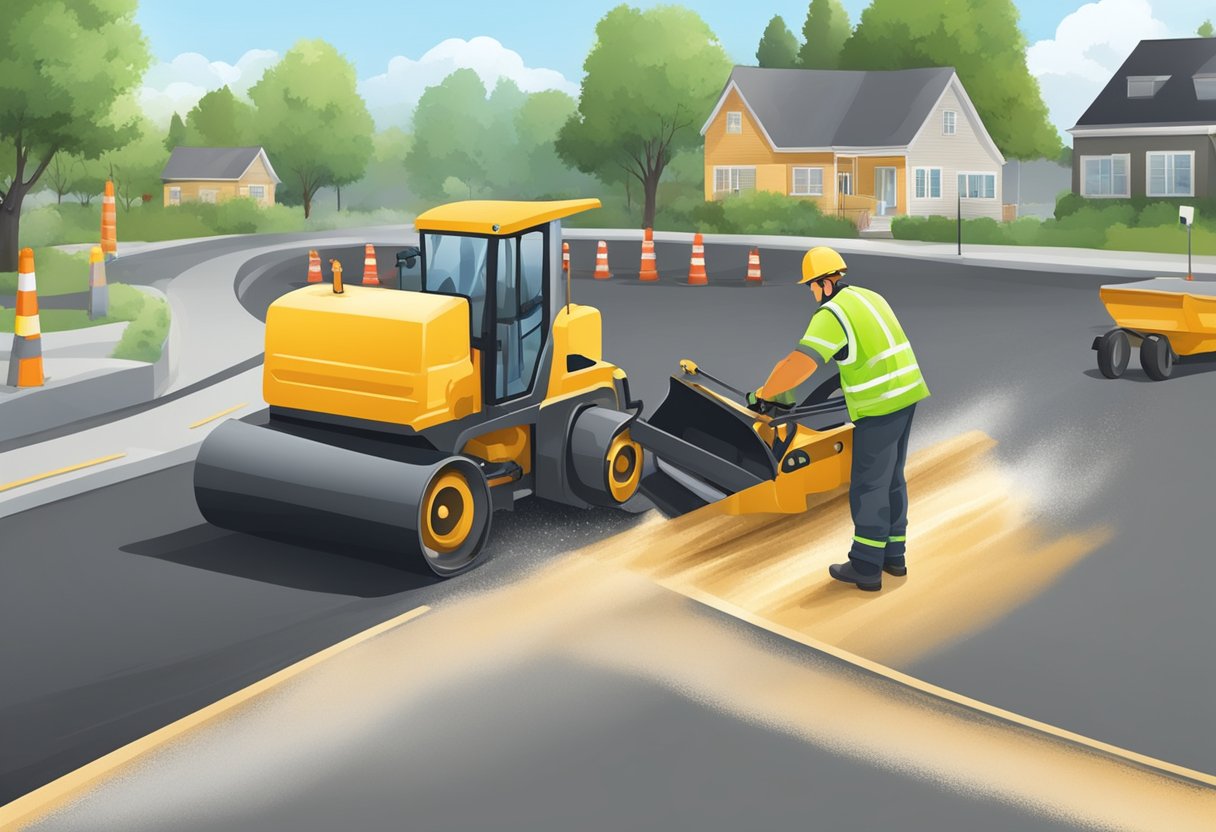Asphalt Paving Essentials: A Comprehensive Guide
Asphalt paving has become a popular choice for many construction projects, providing a durable and cost-effective surface for various applications. Often seen on driveways, parking lots, and roads, the use of asphalt helps create a smooth and long-lasting surface that can withstand heavy use and harsh weather conditions. A trusted company that specializes in these services, such as Asphalt and Paving: Anywhere In Central Texas, can provide expert knowledge and skill to ensure the best results for both commercial and residential projects.
With a focus on quality workmanship, asphalt paving involves the application of a combination of materials, including stone, sand, and a binding agent; this mixture provides the strength and flexibility required for heavy traffic use. The process typically starts with the preparation of the surface, followed by the application of multiple layers of asphalt, ensuring a stable and long-lasting pavement that can handle wear and tear. To learn more about asphalt paving services and the benefits they offer, you can visit this page.
In addition to its durability, asphalt paving is known for its low maintenance and quick installation process, making it a preferred choice for many property owners and contractors. By adequately maintaining your asphalt surface, it not only extends its lifespan but also keeps it looking fresh and functional.
Types of Asphalt
There are several types of asphalt used for paving, each with its unique properties and applications. The most commonly used types are hot mix asphalt and cold mix asphalt.
Hot mix asphalt is a combination of aggregate and binder that is heated to a high temperature, usually above 300°F, and is produced at a central plant. The heated mixture is then laid and compacted on the road surface using specialized equipment. Hot mix asphalt is ideal for moderate to heavy traffic areas due to its durability and capability to withstand wear and tear.
Cold mix asphalt is created by blending the aggregate and binder at ambient temperatures. This type of asphalt is generally used for temporary fixes, such as filling potholes or temporary roads. Cold mix asphalt is not as durable as hot mix asphalt, making it less suited for high-traffic areas. However, its ability to be applied and compacted at lower temperatures makes it an excellent choice for emergency repairs.
Asphalt pavement can be made from different types of aggregate, which affects the overall performance and stability of the material. The most common types of aggregate used are crushed stone, gravel, and sand. The choice of aggregate depends on the required strength, durability, and skid resistance of the pavement.
Recycled asphalt is an increasingly popular sustainable option that involves reusing old asphalt pavement. The old pavement is crushed and mixed with new binder material, resulting in a cost-effective and environmentally friendly solution. This process can significantly reduce the amount of new raw materials required, thus conserving natural resources and reducing waste. Recycled asphalt driveways can be a great alternative for homeowners looking for a sustainable and durable option.
Another recycled option is the use of crushed asphalt in driveway construction. Crushed asphalt, also known as reclaimed asphalt pavement (RAP), can be an excellent choice for driveway pavements due to its cost-efficiency and ease of installation. The crushed asphalt driveway method is gaining popularity as it offers the benefits of environmental conservation and potential cost savings.
In summary, there are various types of asphalt available, each with its unique properties and applications. Factors such as traffic levels, climate, and sustainability should be considered when choosing the appropriate type of asphalt for a specific project.
Preparation for Paving
Before beginning any asphalt paving project, thorough preparation is essential to ensure a quality result. The first step is to evaluate the soil condition and make any necessary adjustments to the base. It is crucial to ensure a stable and well-draining foundation to support the weight of traffic and withstand environmental factors.
Proper grading plays a significant role in the overall durability and drainage of the asphalt. The slope should be set at a minimum of 2% to ensure adequate drainage and to prevent water from pooling on the surface. This can help in avoiding premature deterioration of the pavement and extend its lifespan.
In some cases, the installation of a subbase might be necessary to provide additional support and stability to the pavement. A subbase consists of a layer of material–typically made up of an aggregate base–which is placed directly beneath the asphalt layer. The use of a subbase can improve the overall load-bearing capacity of the pavement and can be especially beneficial in regions with poor soil conditions or heavy traffic loads. For a free analysis of your specific asphalt paving needs, you can Schedule Free Asphalt Paving Quote.
When preparing the site for paving, it is essential to consider Accessibility Considerations for New Driveway Construction. Thoughtful planning and design can minimize the risk of injury and ensure that the appropriate safety measures are in place.
Overall, thorough and careful preparation is crucial to the success of any asphalt paving project. By addressing the soil condition, grading and slope, as well as considering accessibility, you can expect a long-lasting and reliable pavement that meets your specific needs.
Overall, thorough and careful preparation is crucial to the success of any asphalt paving project. By addressing the soil condition, grading and slope, as well as considering accessibility, you can expect a long-lasting and reliable pavement that meets your specific needs.
Paving Process
The asphalt paving process begins with the design of the pavement structure. This includes determining the appropriate thickness for each layer of asphalt and selecting the materials to be used. Engineers will evaluate factors such as traffic volume, climate, and soil conditions to create a suitable design for the project.
Once a design is established, it’s time for installation. The process starts with the preparation of the area, removing any existing pavement, and grading the surface. A stable base is then constructed, commonly consisting of crushed aggregate. This ensures proper drainage and support for the asphalt layers.
Following base construction, the first asphalt layer is applied. This is typically a dense-graded mix that provides a strong foundation for the subsequent layers. Compaction is an essential step in the process. By using rollers, the asphalt is compressed, resulting in increased density and strength. Proper Asphalt Resurfacing in College Station ensures a smoother surface and increased longevity.
A second asphalt layer, known as the overlay, is then laid on top of the first one. This layer provides a smoother surface for vehicles and improves overall appearance. It may consist of a more open-graded mix, offering better skid resistance and reduced splash and spray during rain events.
Compacting this final layer is just as important as the first. Compaction ensures that the overlay is firmly bonded to the underlying base and that the pavement can better withstand traffic loads. The Road Pavement In Texas process entails seven steps, providing valuable information on the various aspects of paving.
The entire asphalt paving process results in a durable and reliable pavement structure. Timely maintenance and repairs can significantly extend the lifespan of the pavement, saving both time and money in the long run. When considering the various paving options, Asphalt Paving College Station offers valuable insights to make the best choice for your project.
Materials and Costs
Asphalt paving involves the use of various materials and incurs specific costs to achieve a smooth and durable surface. The primary component of asphalt paving is concrete, which is a mixture of cement, water, and aggregates such as sand or crushed stone. Concrete services often include crack filling, seal coating, and related maintenance processes to enhance the longevity of the pavement.
Another essential element in asphalt paving is the oil, also known as bitumen, which binds the aggregates to create a cohesive and flexible mixture. The cost of oil can affect the overall price of asphalt paving, as it is sensitive to fluctuations in global oil markets. In addition to the material costs, concrete contractors must design detailed plans and utilize their knowledge and skills to ensure a successful project.
Before laying the asphalt, preparing a robust gravel base is crucial in creating a strong foundation for the pavement. The gravel base typically consists of a layer of compacted crushed stone, which helps with water drainage and adds structural support. The cost of crushed stone and other materials like sand also factors in the overall pricing of the pavement service.
Labor cost is another significant component of the overall expenses in asphalt paving projects. Professionals need to clear the area, grade the surface, and coordinate with relevant regulatory authorities. Skilled concrete crack filling services may also be needed to address any issues before laying the asphalt pavement.
Fuel costs also play a role in determining the final price of asphalt paving. The machinery used in the construction and transportation of materials relies on fuel, which ultimately affects the project’s overall costs. As fuel prices fluctuate, the cost of the asphalt paving services may vary.
Accounting for the costs of materials like concrete, oil, and crushed stone, as well as labor and fuel expenses, is crucial in determining the overall price of asphalt paving projects. While keeping these factors in mind, clients can efficiently collaborate with contractors to achieve the desired results for their pavement.






